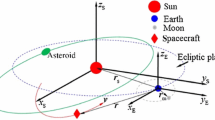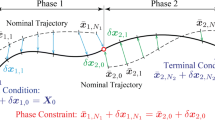Abstract
Near-Earth asteroids have gained a lot of interest and the development in low-thrust propulsion technology makes complex deep space exploration missions possible. A mission from low-Earth orbit using low-thrust electric propulsion system to rendezvous with near-Earth asteroid and bring sample back is investigated. By dividing the mission into five segments, the complex mission is solved separately. Then different methods are used to find optimal trajectories for every segment. Multiple revolutions around the Earth and multiple Moon gravity assists are used to decrease the fuel consumption to escape from the Earth. To avoid possible numerical difficulty of indirect methods, a direct method to parameterize the switching moment and direction of thrust vector is proposed. To maximize the mass of sample, optimal control theory and homotopic approach are applied to find the optimal trajectory. Direct methods of finding proper time to brake the spacecraft using Moon gravity assist are also proposed. Practical techniques including both direct and indirect methods are investigated to optimize trajectories for different segments and they can be easily extended to other missions and more precise dynamic model.
Similar content being viewed by others
References
Sánchez J P, McInnes C. Available Asteroid Resources in the Earths Neighbourhood. In: Asteroids V B, ed. Berlin, Heidelberg: Springer, 2013. 439458
Yárnoz D G, Sanchez J P, McInnes C. Easily retrievable objects among the NEO population. Celest Mech Dyn Astron, 2013; 116: 367–388
Strange N, Landau T M, Lantoine G, et al. Overview of mission design for NASA asteroid redirect robotic mission concept. In: Proceedings of 33rd International Electric Propulsion Conference. Washington D C: The George Washington University, 2013
Mingotti G, Sánchez J P, McInnes C. Combined low-thrust propulsion and invariant manifold trajectories to capture NEOs in the Sun-Earth circular restricted three-body problem. Celest Mech Dyn Astron, 2014; 120: 309–336
Mingotti G, Sanchez J P, McInnes C. Low energy, lowthrust capture of near earth objects in the Sun-Earth and Earth-Moon restricted three-body systems. In: Proceedings of SPACE Conferences & Exposition. American Institute of Aeronautics and Astronautics. San Diego, 2014
Hou X Y, Liu L. Double lunar swing-by orbits revisited. Sci China-Phys Mech Astron, 2014; 57: 784–790
Liu X D, Baoyin H X, Ma X R. Dynamics of surface motion on a rotating massive homogeneous body. Sci China-Phys Mech Astron, 2013; 56: 818–829
Wang S, Shang H B, Wu W R. Interplanetary transfers employing invariant manifolds and gravity assist between periodic orbits. Sci China-Phys Mech Astron, 2013; 56: 786–794
Xu M, Tan T, Xu S J. Research on the transfers to Halo orbits from the view of invariant manifolds. Sci China-Phys Mech Astron, 2012; 55: 671–683
Chen Y, Baoyin H X, Li J F. Trajectory design for the Moon departure libration point mission in full ephemeris model. Sci China Tech Sci, 2011; 54: 2924–2934
Qi R, Xu S J, Chen T. Control of orientation for spacecraft formations in the vicinity of the Sun-Earth L2 libration point. Sci China-Phys Mech Astron, 2014; 57: 1778–1787
Chen Y, Baoyin H X, Li J F. Design and optimization of a trajectory for Moon departure Near Earth Asteroid exploration. Sci China-Phys Mech Astron, 2011; 54: 748–755
Rayman M D, Varghese P, Lehman D H, et al. Results from the deep space 1 technology validation mission. Acta Astron, 2000, 47: 475487
Racca G, Marini A, Stagnaro L, et al. SMART-1 mission description and development status. Planet Space Sci, 2002; 50: 1323–1337
Kawaguchi J, Fujiwara A, Uesugi T K. The Ion Engines Cruise Operation And The Earth Swingby Of Hayabusa (Muses-C). In: Proceddings of the 55th International Astronotical Congress. Vancouver. 2004
Rayman M D, Fraschetti T C, Raymond C A, et al. Coupling of system resource margins through the use of electric propulsion: Implications in preparing for the Dawn mission to Ceres and Vesta. Acta Astron, 2007; 60: 930–938
Hargraves C R, Paris S W. Direct trajectory optimization using nonlinear programming and collocation. J Guidance Control Dyn, 1987; 10: 338–342
Enright P J, Conway B A. Discrete approximations to optimal trajectories using direct transcription and nonlinear programming. J Guidance Control Dyn, 1992; 15: 994–1002
Sims J, Finlayson P, Rinderle E, et al. Implementation of a low- thrust trajectory optimization algorithm for preliminary design. In: Proceed ings of AIAA/AAS Astrodynamics Specialist Conference and Exhibit, Guidance, Navigation, and Control and Co-located Conferences. Colorado: American Institute of Aeronautics and Astronautics, 2006
Kechichian J A. Optimal low-earth-orbit-geostationary-earth-orbit intermediate acceleration orbit transfer. J Guidance Control Dyn, 1997; 20: 803–811
Guo T D, Jiang F H, Baoyin H X, et al. Fuel optimal low thrust rendezvous with outer planets via gravity assist. Sci China-Phys Mech Astron, 2011; 54: 756–769
Ranieri C L, Ocampo C A. Indirect optimization of three-dimensional finite-burning interplanetary transfers including spiral dynamics. J Guidance Control Dyn, 2009; 32: 445–455
Gong S P, Li J F. Fuel consumption for interplanetary missions of solar sailing. Sci China-Phys Mech Astron, 2014; 57: 521–531
Jiang F H, Baoyin H X, Li J F. Practical techniques for low-thrust trajectory optimization with homotopic approach. J Guidance Control Dyn, 2012; 35: 245–258
Cai X S, Li J F, Gong S P. Solar sailing trajectory optimization with planetary gravity assist. Sci China-Phys Mech Astron, 2015; 58: 1–11
Bertrand R, Epenoy R. New smoothing techniques for solving bangbang optimal control problemsnumerical results and statistical interpretation. Opt Control Appl Meth, 2002; 23: 171–197
Zhang P, Li J F, Gong S P. Fuel-optimal trajectory design using solar electric propulsion under power constraints and performance degradation. Sci China-Phys Mech Astron, 2014; 57: 1090–1097
Kluever C A, Pierson B L. Optimal low-thrust three-dimensional earthmoon trajectories. J Guidance Control Dyn, 1995; 18: 830–837
Gao Y, Kluever C A. Low-thrust interplanetary orbit transfers using hybrid trajectory optimization method with multiple shooting. AIAA Paper, 2004, AIAA 2004-5088
Hull D G. Conversion of optimal control problems into parameter optimization problems. J Guidance Control Dyn, 1997; 20: 57–60
Seywald H. Trajectory optimization based on differential inclusion (Revised). J Guidance Control Dyn, 1994; 17: 480–487
Guo T, Jiang F, Li J. Homotopic approach and pseudospectral method applied jointly to low thrust trajectory optimization. Acta Astron, 2012; 71: 38–50
Kim Y H, Spencer D B. Optimal spacecraft rendezvous using genetic algorithms. J Spacecraft Rockets, 2002; 39: 859–865
Zhu K, Jiang F, Li J, et al. Trajectory optimization of multi-asteroids exploration with low thrust. Jpn Soc Aeron Space Sci Trans, 2009; 52: 47–54
Casalino L, Colasurdo G, Pastrone D. Optimal low-thrust escape trajectories using gravity assist. J Guidance Control Dyn, 1999, 22: 637642
Mantia M L, Casalino L. Indirect optimization of low-thrust capture trajectories. J Guidance Control Dyn, 2006; 29: 1011–1014
Nah R, Vadali S, Braden E. Fuel-optimal, low-thrust, threedimensional Earth-Mars trajectories. J Guidance Control Dyn, 2001, 24: 11001107
Mengali G, Quarta A A. Trajectory design with hybrid low-thrust propulsion system. J Guidance Control Dyn, 2007; 30: 419–426
Haberkorn T, Martinon P, Gergaud J. Low thrust minimum-fuel orbital transfer: A homotopic approach. J Guidance Control Dyn, 2004; 27: 1046–1060
Thevenet J B, Epenoy R. Minimum-fuel deployment for spacecraft formations via optimal control. J Guidance Control Dyn, 2008, 31: 101113
Kawaguchi J, Yamakawa H, Uesugi T, et al. On making use of lunar and solar gravity assists in LUNAR-A, PLANET-B missions. Acta Astron, 1995; 35: 633–642
Uphoff C W. The art and science of lunar gravity assist. Adv Astron Sci, 1989; 69: 333–346
Macdonald M, McInnes C. Spacecraft planetary capture using gravityassist maneuvers. J Guidance Control Dyn, 2005; 28: 365–369
Sims J A. Delta-V gravity-assist trajectory design: Theory and practice. Dissertation for Doctoral Degree. West Lafayette: School of Aeronautics and Astronautics, Purdue University, 1997
Pontryagin L S. Mathematical Theory of Optimal Processes. New York: Wiley-Interscience, 1962
Gergaud J, Haberkorn T. Orbital transfer: Some links between the lowthrust and the impulse cases. Acta Astron, 2007; 60: 649–657
Gill P E, Murray W, Saunders M A. SNOPT: An SQP algorithm for large-scale constrained optimization. SIAM J Opt, 2002; 12: 979–1006
Burden R L, Faires J D. Numerical Analysis. 3rd ed. Boston/Mass: Prindle, Weber & Schmidt, 1985
More J J, Garbow B S, Hillstrom K E. User guide for MINPACK-1. Report. Argonne National Lab. ANL-80-74, 1980
Powell M J. A hybrid method for nonlinear equations. Numer Methr Nonlinear Algeb Equat, 1970; 7: 87–114
Author information
Authors and Affiliations
Corresponding author
Rights and permissions
About this article
Cite this article
Tang, G., Jiang, F. & Li, J. Low-thrust trajectory optimization of asteroid sample return mission with multiple revolutions and moon gravity assists. Sci. China Phys. Mech. Astron. 58, 114501 (2015). https://doi.org/10.1007/s11433-015-5699-y
Received:
Accepted:
Published:
DOI: https://doi.org/10.1007/s11433-015-5699-y




